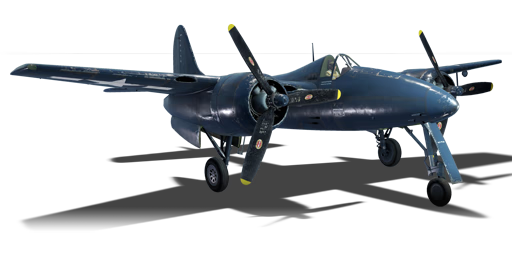



By around 1938, the US Navy had started investigating the possibilities of a twin-engine carrier-borne fighter. Quickly thereafter, the XF5F Skyrocket was designed. The compact aircraft was to include a 23 mm Madsen cannon, two .50 calibre machine guns, and two .30 calibre machine guns. The Skyrocket test results were not very satisfactory, and in 1941 the US Navy moved on to a new aircraft. The XF7F-1 Tigercat prototype made its original flight on December 2, 1943. The F7F-1 aircraft went into production in April of 1944, but the Midway-class carriers had not yet been completed, so the first Tigercats were given to the US Marine Corps. Only 35 of these aircraft were built until production switched to the two-seat night fighter variant. These were also built in limited numbers.
Introduced in Update 1.43, the Tigercat is a typical heavy fighter, having great firepower and survivability but low agility. For those reasons, it's crucial to be near teammates, as it will struggle to dogfight single-engine fighters. It performs best at medium to low altitudes. Its best performance advantage is speed - it's one of the fastest propeller-driven aircraft in the game. Despite this, and due to its high drag, the Tigercat will get caught in a dive by many fighters. The climb rate is mediocre, helped only by its air spawn. Players will want to utilise a hit-and-run playstyle, similarly to early-WWII American fighters like the P-51D-5 or P-47D-25. Unlike those, however, it can't just dive away from threats, making it significantly harder to play. Additionally, it overheats easily on automatic engine controls, and the availability of WEP is time-limited.
flaps
flaps
flaps
brake
| Belt | Belt filling | Armor penetration (mm) at a distance: | |||||
|---|---|---|---|---|---|---|---|
| 10 m | 100 m | 500 m | 1000 m | 1500 m | 2000 m | ||
| HEF-I/AP-T | 36 | 33 | 23 | 15 | 9 | 6 | |
| AP-T/AP-T/HEF-I/HEF-I | 36 | 33 | 23 | 15 | 9 | 6 | |
| HEF-I/HEF-I/HEF-I/AP-T | 36 | 33 | 23 | 15 | 9 | 6 | |
| AP-T/AP-T/AP-T/HEF-I | 36 | 33 | 23 | 15 | 9 | 6 | |
| HEF-I | 5 | 4 | 3 | 2 | 2 | 2 | |
| Belt | Belt filling | Armor penetration (mm) at a distance: | |||||
|---|---|---|---|---|---|---|---|
| 10 m | 100 m | 500 m | 1000 m | 1500 m | 2000 m | ||
| API-T/AP/AP/I | 30 | 27 | 20 | 13 | 9 | 6 | |
| AP-I/AP-I/API-T/I/I | 28 | 26 | 18 | 11 | 7 | 4 | |
| API-T/I/AP/AP/AP-I/AP-I | 30 | 27 | 20 | 13 | 9 | 6 | |
| API-T | 28 | 26 | 18 | 11 | 7 | 4 | |
| AP-I/I/AP-I/I | 28 | 26 | 18 | 11 | 7 | 4 | |
2 × 500 lb AN-M64A1 bomb












Flight performance | |
|---|---|
Weaponry | |
|---|---|